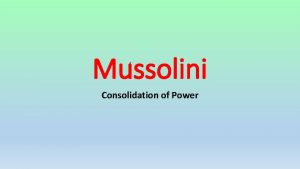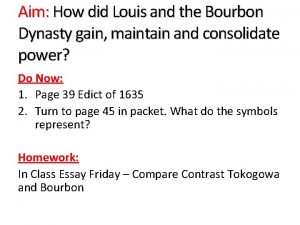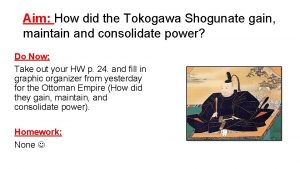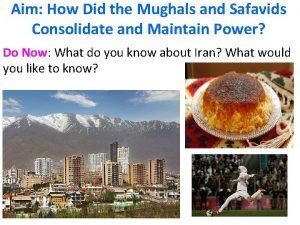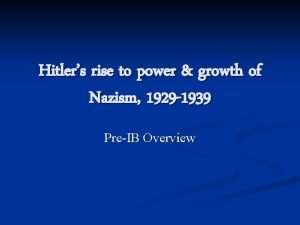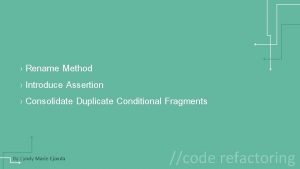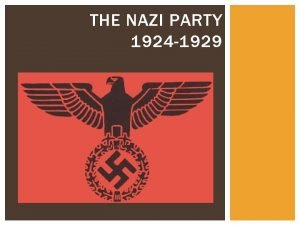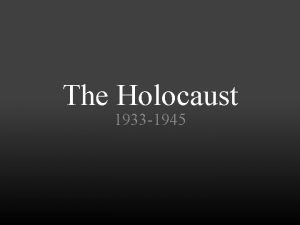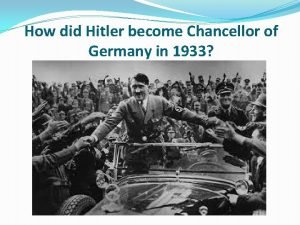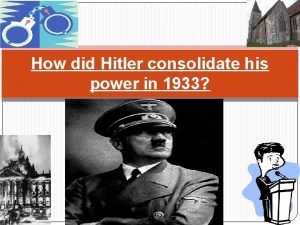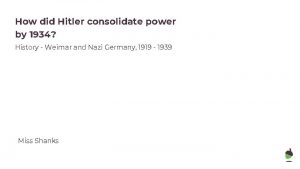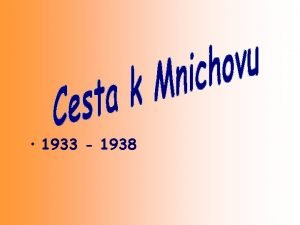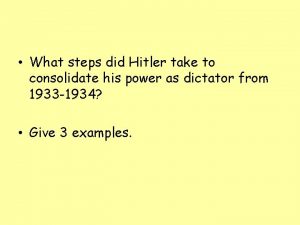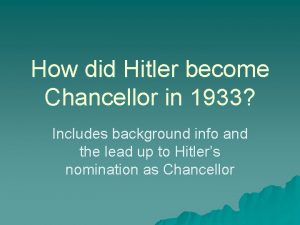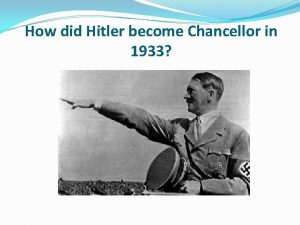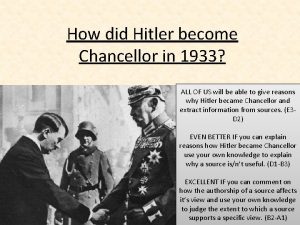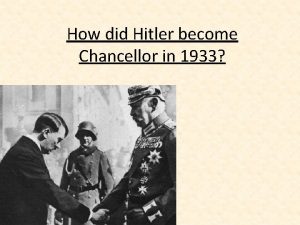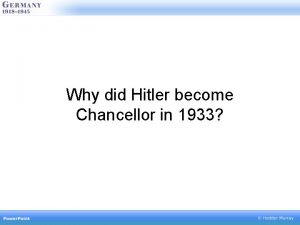How did Hitler consolidate power 1933 34 LO












- Slides: 12

How did Hitler consolidate power 1933 -34? L/O – To identify the steps Hitler took in dismantling the Weimar Republic and consolidating his power

What problems did Hitler face? • Hitler was appointed Chancellor on 30 th January 1933. Yet his power was limited. The Weimar constitution controlled the Chancellor’s power and Hindenburg still retained all the powers of President. • Hitler’s cabinet of 11 ministers only had two Nazi members. The others were from the German National People’s Party (DNVP). Only 1/3 of the Reichstag members were Nazis (196). • To get a bigger majority, he immediately insisted on new Reichstag elections for the 5 th March 1933.

The Reichstag Fire • On 27 th February 1933, the Reichstag building was destroyed by fire. • A young Dutch communist, Marinus van der Lubbe, was caught on site. He confessed, was put on trial and executed. He was beheaded! • Hitler declared that the fire was part of a communist conspiracy and the next day he persuaded Hindenburg to pass the ‘Decree of the Reich President for the Protection of People and State’ giving Hitler Article 48 powers.


Order of the Reich President for the Protection of People and State On the basis of Article 48 paragraph 2 of the Constitution of the German Reich, the following is ordered in defense against Communist stateendangering acts of violence: § 1. Articles 114, 115, 117, 118, 123, 124 and 153 of the Constitution of the German Reich are suspended until further notice. It is therefore permissible to restrict the rights of personal freedom [habeas corpus], freedom of (opinion) expression, including the freedom of the press, the freedom to organize and assemble, the privacy of postal, telegraphic and telephonic communications. Warrants for House searches, orders for confiscations as well as restrictions on property, are also permissible beyond the legal limits otherwise prescribed.

The Reichstag Fire Decree • The Reichstag Fire Decree gave Hitler the power to suspend all the articles of the constitution which guaranteed personal liberty, freedom of speech, press and assembly. • The police, which in the state of Prussia was controlled by Nazi Minister of the Interior Hermann Goering, now had powers to search houses, confiscate property and detain people indefinitely without trial. • It also degreed the death penalty for many crimes!

The March 1933 Elections • With the decree in place, in the run-up to the 5 th March elections, the Nazis could ban political meetings, close newspapers, round up political opponents and even close the State radio station! • In Prussia alone, over 4, 000 communists were arrested. Only Nazis were allowed to campaign for the election! • On the day itself, thousands of uniformed Nazis policed polling stations, watching over people as they marked their ballots!

The March 1933 Elections • The Nazis achieved their best results – 288 seats. Despite having the support of the DVNP, they still didn’t have the 2/3 majority needed in the Reichstag to change the Constitution (431 seats). • Hitler wanted to change the constitution to introduce an ‘Enabling Act’ which would give him the power to pass laws without consulting the Reichstag. • First he used his emergency powers to stop the 81 communists taking their seats. Nazis 288 seats Nationalists (DVNP) 52 Social Democrats (SPD) 120 Communists 81 Centre Party 74 Others 32 Total 647

The Enabling Act is Passed • When the Reichstag met at the Kroll Opera House in Berlin on 23 rd March, Hitler proposed the ‘Enabling Act’. Nazis 288 seats Nationalists (DVNP) 52 Social Democrats (SPD) 120 Communists 81 Centre Party 74 • With the communists out of the way, he used intimidation to scare the SDP and others to vote for the act. SA and SS men surrounded the politicians, chanting and threatening murder. • Whilst many still voted against, most gave into the pressure. The Enabling Act was passed by 444 votes to 94. Others 32 Total 647

The Enabling Act is Passed • The Enabling Act (Law to Remedy the Distress of People and Reich) gave Hitler the power to pass laws for 4 years without the need to consult the Reichstag or President! • Along with the Reichstag Fire Decree which removed civil liberties, the two laws transformed Hitler’s government into a de facto legal dictatorship. • The passing of the Enabling Act gave Hitler full power to do what he wanted. Over the next 6 months Hitler transformed Germany.


What did Hitler do next? • Banned Trade Unions – Hitler also made strikes illegal. If communists could control the trade unions, they could use strikes to cripple Hitler’s government. • Banned Political Parties – In July 1933, Hitler decreed a new law called ‘Law Against the Establishment of Parties. ’ Article 1 removed all opposition to the NSDAP. • Abolished Local Government – In Jan 1934, Hitler abolished the regional (Länder) parliaments and each region would be ruled by a governor appointed by him.
 How did mussolini consolidate power
How did mussolini consolidate power How did louis xiv gain, consolidate, and maintain power?
How did louis xiv gain, consolidate, and maintain power? Tokogawa
Tokogawa How did the safavids consolidate power
How did the safavids consolidate power How do empires consolidate their power?
How do empires consolidate their power? How did hitler rise to power
How did hitler rise to power Data warehouses generalize and consolidate data in
Data warehouses generalize and consolidate data in Consolidate duplicate conditional fragments
Consolidate duplicate conditional fragments The 12 core values
The 12 core values What happened after hitler came to power
What happened after hitler came to power Holocaust
Holocaust Nazi partys
Nazi partys How did hitler become chancellor of germany
How did hitler become chancellor of germany
